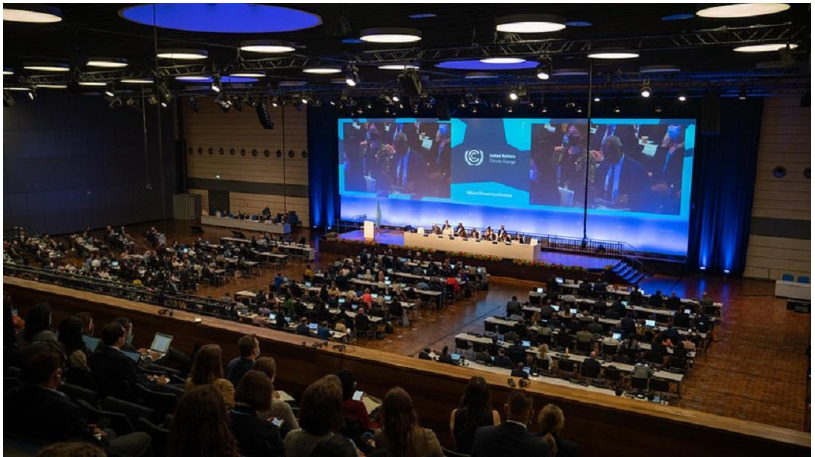The five pillars of climate action we will raise at the Bonn Climate Conference
The UN COP28 summit in the UAE this December will set the stage for a ratcheting up of climate action and finance, based on the world’s first comprehensive stocktake since the Paris Agreement came into force of what is working so far – and what is not.
The United Nations’ Bonn Climate Change Conference, from 5-15 June, marks an important stop on the road to COP28, providing national and local governments, businesses, investors and civil society an opportunity to showcase the work already underway and the opportunities ready to be seized.
In signing the 2015 Paris Agreement, countries acknowledged that governments cannot achieve this economic transformation alone – businesses, investors, cities and regions need to get involved. They therefore created the Global Stocktake, a five-yearly review by countries to assess progress towards its goals, starting in 2023.
Coming out ahead of COP28, the stocktake report will show that action is falling short of what the science requires: to halve emissions between 2020 and 2030, build adaptive capacity and resilience, end biodiversity loss, and address climate losses and damages by 2030.
As the High-Level Champions, we are working to strengthen efforts from businesses, investors, cities and regions across the five key pillars of climate action within this decade: mitigation; adaptation and resilience; finance; nature; climate losses and damages; and inclusivity, especially of youth, women and indigenous peoples.
At the same time, we continue to work on enhancing the transparency of progress on climate commitments from non-state actors and accountability and collaboration within the Race to Zero campaign.
Mobilizing finance
Finance at scale that is more accessible and affordable is what will turn objectives and promises into tangible change on the ground – in cutting emissions, building adaptation and resilience, ending nature loss, and addressing loss and damage.
Emerging markets and developing countries will require around US$1 trillion per year in external finance by 2030, according to the Finance for Climate Action Report commissioned by the COP26 and COP27 presidencies and the High-Level Champions. Yet developed countries have yet to meet a pledge to mobilize US$100 billion per year in public and private finance from 2020 onwards.
Finance for nature needs to double to US$384 billion per year by 2025 in order to achieve global goals for biodiversity and land protection, according to the UN Environment Programme. Private capital accounts for a mere 17 percent of finance and, therefore, must be increased.
Raising “just” finance is a top priority. It must address the adaptation gap, strengthen resilience, support a just energy transition and address loss and damage, with a focus on developing countries. We are keen to promote the use of innovative climate financing tools, instruments and solutions and improve access to climate finance.
Currently, small island nations, least developed countries and Africa are most in need but face the biggest obstacles in attracting finance because of mounting public debt and unappealing, risky business environments. We can change this by advancing a global pipeline of implementable, financeable and investable projects for emerging markets and developing economies, to both cut emissions and build adaptation.
Egypt’s COP27 Presidency, the UN Regional Commissions and the High-Level Champions last year held regional forums for financiers, businesses, governments and others, presenting more than 400 projects costing a combined US$566 billion. This year, the Champions are working to match those projects with commercial banks, multilateral development banks, sovereign wealth funds, and foundations, to have a fair percentage financed by COP28.
Building adaptation and resilience
While we must race to zero emissions in order to avoid the worst impacts of climate change, we must also ensure that the most vulnerable communities can survive and thrive in a world with more extreme temperatures, cyclones, droughts, floods and other changes.
The Sharm El-Sheikh Adaptation Agenda, agreed at COP27, creates the first comprehensive global plan to rally countries and non-state actors behind adaptation and resilience work. It sets out 30 targets to advance planning and finance for transformative solutions in five impact systems: food, water, oceans, human settlements, and infrastructure.
The COP27 Presidency, the High-Level Champions and other partners are now working to rally national and local governments and the private sector behind these targets. We want to identify the partnerships needed to deliver on each target; discuss the baselines and tracking of progress on each target; help shape a common narrative for adaptation system transformation; and channel inputs from partners.
To build this momentum, we are holding an event on the Sharm El-Sheikh Agenda in Bonn on 12 June where we will present task forces, define their priorities and begin to mobilize action and finance.
Nature regeneration
Nature is at the heart of both our efforts to reduce emissions and build adaptation and resilience. Forests, peatlands, mangroves and marshes are natural climate regulators – they absorb and store carbon, and buffer people from impacts such as rising sea levels, cyclones and extreme heat.
Nature-based solutions could yield nearly a third of emission reductions needed to stay within 1.5C of warming, or close to 7 gigatonnes of CO2 equivalent per year by 2030, according to McKinsey. That mainly includes ending deforestation and peatland damage, increasing reforestation, and managing agricultural soil so that it sequesters carbon.
Nature-positive business is good business. Industry action that benefits nature is worth up to US$10.1 trillion in business opportunities, and could create some 395 million jobs by 2030, according to the World Economic Forum.
Businesses and investors can start to seize these opportunities – starting with eliminating deforestation across their value chains. They can work with governments to improve incentives for bankable nature-based solutions, mature the project pipeline and build up technical capacity.
Addressing climate losses and damages
We cannot ignore the fact that people living on the frontlines of climate change have already sustained tragic losses and damages as a result of impacts such as cyclones, droughts, floods, wildfires, rising sea levels and extreme temperatures. The worst-hit people are often the most vulnerable: those living in small island and least developed nations, women, and Indigenous peoples.
A breakthrough was achieved at COP27 last year, establishing a loss and damage fund and additional new funding arrangements. Now we need to operationalize and fill the fund, and disburse its resources with speed, scale to those developing countries suffering losses and damages as a result of negative climate impacts. There is no time to lose.
To highlight examples of work already underway by non-state actors, we are holding an event, Actions After Impacts, in Bonn on 9 June. This will also outline the challenges and opportunities presented by mobilising private finance for loss and damage, and set out a roadmap for increasing action ahead of COP28.
Cross-cutting prioritization of inclusivity across all efforts
To succeed, climate action must include everyone – global south, global north, women, indigenous peoples, youth and others. To make it inclusive and holistic, we need to mobilize finance, facilitate knowledge sharing, and build capacity in communities. We need to make it a just transition that supports and accelerates the UN’s Sustainable Development Goals for 2030, and we must do it in a way that protects and restores nature.
To elevate the role of youth in climate action, we are holding an event in Bonn on 8 June, The Youth Stocktake: An assessment of the challenges for youth inclusion in UNFCCC processes and a roadmap for the future.
Here, we will run a Youth Stocktake aligned with the Global Stocktake process. It will also establish a catalogue of easily-accessible capacity building content, and review the process by which youth can make inputs into the UN climate talks.
In drawing attention to the biggest gaps, challenges, opportunities and solutions that are sure to emerge in the Global Stocktake this year, the Bonn Climate Change Conference will begin to build momentum towards a global ratcheting up of action at COP28.




